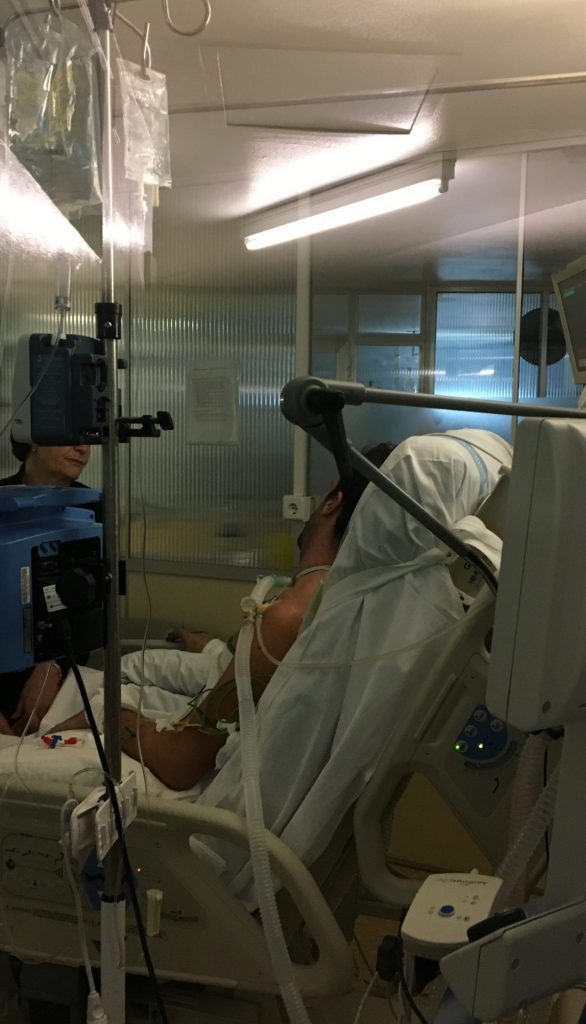My accident
Discover the story of my accident:

On January 17, 2017, in a gym near Barcelona, I had an aneurysm rupture.
Suddenly, I felt a very strong pain in my head.
I then felt that my legs were no longer supporting me and I gradually lost consciousness.
I remember lying on my stomach, thinking that I was going to die on the spot because the pain was so violent.
+ Report of the operation.

Acute intraparenchymal hematoma located on the upper part of the vermis of the cerebellum of approximately 34x35x42mm, with disruption of the vascular system through the 4th ventricle as well as a multitude of hemorrhages in the 3rd ventricle, lateral ventricles as well as in the frontal cavities with signs of obstructive hydrocephalus.
In addition, there is hyperdensity of the tentorio (meninges) and hyperdense occupation of the left occipital cortical sulci in relation to the subarachnoid hemorrhage. Hypodensity of the perilesional white matter of the superior vermian collection in relation to an edema, producing a protrusion on the brainstem anteriorly that appears hypodense, collapsing the perminesencephalic cisterns, as well as protusion and cephalic displacement of the tentorium in probable relation to a transtentorial hernia.
Descent of the cerebellar tonsils with occupation of the foramen magnum in relation to signs of tonsillar hernia.

There are no conclusive images of intracranial aneurysmal formation or apparent cerebral arteriovenous malformation.
Fetal origin of the left posterior cerebral artery as a variant of normality.
Conclusion:
-Acute superior vermian hematoma and associated SAH of intraventricular predominance with obstructive hydrocephalus and mass effect with signs of transtentorial and tonsillar hermation. Hypotensity of the trunk, probably related to edema.
-No conclusive images of intracranial aneurysm formation or apparent cerebral arteriovenous malformation are observed.
+ Explanations of the accident :

The accident caused my skull to flood. The blood compressed my brain stem and cerebellum.
This part of the brain manages several functions of the human body.
The aneurysm looks like a small pocket on an artery in the brain that has burst as a result of increased blood pressure.
The aneurysm (* https://en.wikipedia.org/wiki/Aneurysm) suffered is certainly due to two factors. The first explanation would be a birth defect of the venous walls irrigating the cerebellum. Fatigue coupled with a sporting practice would have made this artery explode. The second explanation would be that sports practice and physical fatigue would have reduced the thickness of the artery and created a small blood bag. The fact of having an increase in blood pressure caused the rupture of this small pocket of blood that appeared on the artery (aneurysm).
In my case, it is a malformation of the venous system that is at the origin. Physical activity and fatigue aggravated this already existing aneurysm. The blood pressure simply made this small pocket explode. The purpose of the polygon of Willis* is to redirect the blood flow in the brain. My aneurysm ruptured in the area behind the polygon and on the upper part of the cerebellum (vermis).
The only way to verify its presence is to have an MRI to check.
The ruptured aneurysm also resulted in pronounced dysarthria. (* https://en.wikipedia.org/wiki/Dysarthria). I have jerky speech and mild left-sided hemiplegia (https://en.wikipedia.org/wiki/Hemiparesis).
Repetition contributes to an improvement. It is a tedious work but necessary to progress. As some doctors have said, I should no longer be alive due to the various complications.
Medically, I am a victim of cerebellar syndrome (* https://www.amboss.com/us/knowledge/Cerebellar_syndromes).
I walk while trying to move my head and my eyes because they are fixed. The human brain has the ability (like a computer) to process several pieces of information at the same time. It can signal to the body a danger, manage at the same time another thing and all that in a natural way. We speak then of a “multi-task” brain. Mine, following the trauma it has undergone, can only perform one operation at a time. We say that it is a “mono-task” brain. Primitive functions such as breathing and blinking are maintained. The others require a different management. Since the brain no longer acts naturally, I have to make it act in “force mode”. I get tired more quickly because it requires more concentration. I have to control my walking pace, my breath, my balance, a potential danger, etc…
The work of my left hand is done by daily gestures while I no longer benefit from medical administrative support.
I can no longer walk, run, swim, talk, jump, dance, use my left arm, drive, eat, drink,
I had to relearn everything with the help of professionals (occupational therapist, physiotherapist, speech therapist, etc…).
I practice a physical activity in order to maintain my general physical condition.
The white part on the MRI and smaller on image 4 is the part of the cerebellum affected during the accident.




